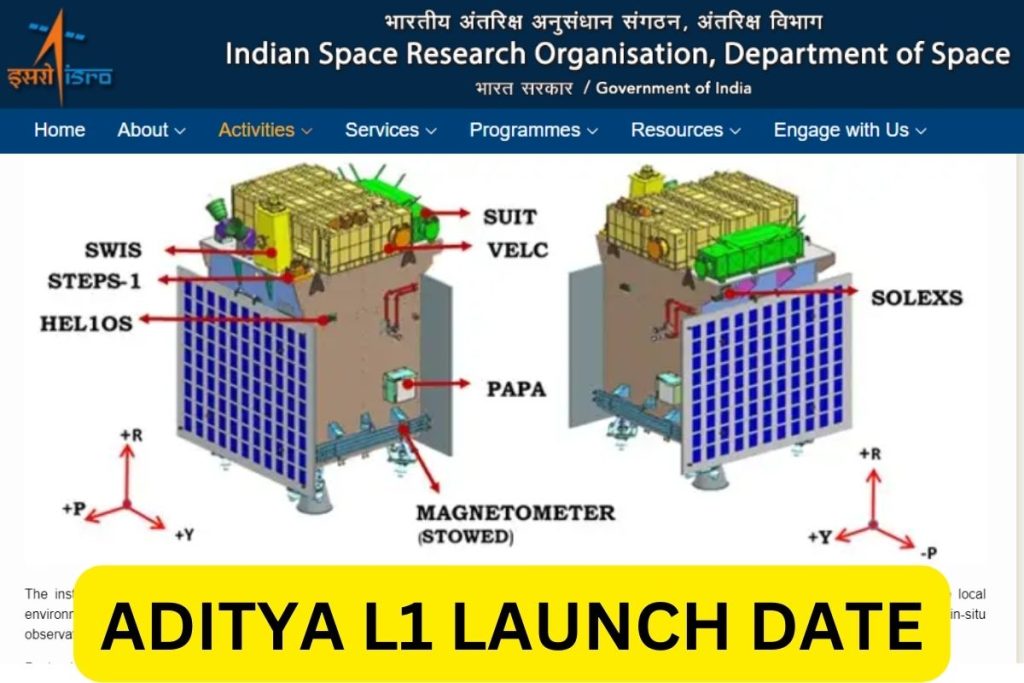The Indian Space & Research Organization (ISRO) is all set to launch the latest spacecraft after the successful landing of Chandrayaan 3. It is to inform you that ISRO is going to Launch Aditya L1 Mission which is the 1st Solar Mission by ISRO. As per details available with us, Aditya L-1 Launch Date is 2nd September 2025 and this mission aims to study the Space Weather and Gases on Sun. You can find the Aditya L1 Mission Details in this post and then you can get to know about the full details. You should know that the Aditya L1 Solar Mission by ISRO is the 1st of its kind and it aims to reach Lagrangian Point (L1) of the Sun Earth Solar System. If you are interested to know about the ISRO Aditya L1 Mission Budget then we want to inform you that it is made on the Rs 400 Crore Budget as on September 2025. You should know that ISRO L1 Launch Vehicle is PSLV-XL on which Spacecraft will reach the Sun’s Orbit. All of us know that ISRO is reaching great heights by giving back to back Successful missions.

Aditya L1 Mission 2025 Launch Date
The Aditya L1 Mission 2025 is announced by the Indian Space & Research Organization as per which this Spacecraft will carry the Payload till Lagrangian Point and it will read the behaviour of Sun. This is the 1st Solar Mission by ISRO and all the citizens are excited for it. Recently, ISRO launched the Chandrayaan 3 Mission and made a successful landing on the South Pole of the moon. Now, continuing their legacy they are going to launch the Aditya L1 Mission 2025 which is the Solar Mission and it will study the Gas Pattern, Coronal Heating & Solar Wind Acceleration. Apart from this, Aditya L1 Mission will carry various Payloads which helps in the Study of Sun from Space. There are various radiations which are emitted by the Sun but they do not reach the Earth’s Surface due to Electromagnetism. So, Indian Space & Research Organization will study these radiations and that is why they are launching the Aditya L-1 Mission. As per information revealed by ISRO, the Aditya L1 Mission Launch Date is 2nd September 2025 and take off will take place at Launch Pad of ISRO. You should know that Aditya L1 Launch Vehicle is PSLV-XL and it will be used to launch the spacecraft in Space.
ISRO Aditya L1 Mission Launch Date
| Mission Name | Aditya L1 |
| Authority | Indian Space & Research Organization |
| Type of Mission | Solar Mission |
| ISRO Aditya L1 Mission Launch Date | 2nd September 2025 |
| Time | To be Announced |
| ISRO Aditya L1 Budget | Rs 400 Crore |
| Objective of Aditya L1 | To Study the Gas Pattern, Coronal Heating & Solar Wind Acceleration |
| Aditya L1 Launch Vehicle | PSLV-XL |
| Landing Site | Lagrangian Point |
| Aditya L1 Launch Ticket | TBA |
| Total Aditya L1 Payload | Check Below |
| Type of Article | News |
| ISRO Website | isro.gov.in |
ISRO Aditya L1 Mission Budget
- The Indian Space & Research Organization works on various Space Missions and recently, they have successfully finished the Chandrayaan 3 mission.
- Now, they are ready to launch a new mission named Aditya L1 on 2nd September 2025 and it is a Solar Mission which aims to make studies related to Gas Pattern, Coronal Heating & Solar Wind Acceleration.
- You should know that ISRO Aditya L1 Mission Budget is Rs 400 Crore and ISRO Started working on Aditya L1 from December 2019.
- The Spacecraft is ready to be launched now and Aditya L-1 Launch will take place on 2nd September 2025.
- Make sure you watch the Launch Event Live on the ISRO Youtube Channel and then you will feel proud of our scientists.
Aditya L1 Payload Details
| Name of the Payload | Working |
| L1 Orbiting X-Ray Spectrometer | Studies the X Ray Flares from the Sun |
| Visible Emission Line Coronagraph (VELC) | Studies Solar Corona and Dynamics of Coronal Mass Ejections |
| Solar UltraViolet Imaging Telescope (SUIT) | It will Image the Solar Photosphere and Chromosphere |
| Aditya Solarwind Particle Experiment and Plasma Analyser Package for Aditya | Study the Solar Wind and Ion Distribution |
| Magnetometer | To Measure Inter-Planetary Magnetic Fields |
Aditya L1 Launch Vehicle
- The Indian Space & Research Organization will Launch the Aditya L1 Solar Mission on 2nd September 2025.
- The Aditya L1 Launch Vehicle is PSLV-XL and it will carry the Spacecraft in Space.
- The launch site is not confirmed yet but most probably the launch will take place at Satish Dhawan Space Centre.
- The Launch Vehicle will carry the Spacecraft in Space and then Aditya L1 will get separated from it.
- Aditya L-1 is the second consecutive mission of ISRO after the launch of Chandrayaan 3.
Aditya L1 Solar Mission : Details
- Check the Points below to know more about the Aditya L1 Solar Mission Details.
- First of all, you should know that this is the 1st Solar Mission by ISRO and launch will take place on 2nd September 2025.
- Secondly, it carries 7 Payloads which we have mentioned above and each payload plays a vital role in the mission.
- Aditya L1 aims to study the Solar Wind Pattern, Energy Pattern and other important information related to the Sun.
- Lagrangian point 1 (L1) is the Landing Point where Aditya 1 will be placed to study the Sun Pattern.
Frequently Asked Topics on Aditya L1 Launch Date & Time
When is the Aditya L1 Launch Date?
Aditya L1 Launch Date is on 2nd September 2025.
How much Payload will Aditya L1 Carry?
You should know that Aditya L1 will carry 7 different types of Payloads.
What is the ISRO Aditya L1 Budget?
Aditya L1 Budget is Rs 400 Crore.
What is the Aditya L1 Launch Vehicle?
Aditya L1 Launch Vehicle is PSLV-XL.
Hi, i am Krishna Iyer an incredibly talented educational content writer hailing from India. I always had a passion for education and a deep love for writing with a natural curiosity and a thirst for knowledge, which led to a keen interest in various academic subjects. I obtained a degree in English literature. With a strong educational background and a passion for writing, I embarked on a career as an educational content writer. They have since worked with various educational institutions, creating engaging and informative content for students of all ages. My writing style is known for its clarity, creativity, and ability to simplify complex ideas, making learning a joyful experience for students.
